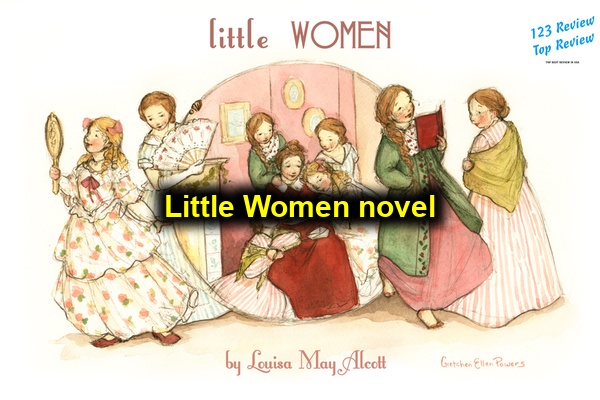Set against the backdrop of the American Civil War, Little Women explores themes of family, personal growth, morality, and the societal roles of women. At its heart, the novel is a coming-of-age story about the four March sisters—Jo, Meg, Beth, and Amy—as they navigate the complexities of adolescence and adulthood.

In this article, 123 Review will delve into the core themes of the novel, provide an in-depth character analysis, explore the novel’s historical context, and evaluate its critical reception, literary style, and feminist elements. We will also examine the numerous adaptations of Little Women and assess the novel’s enduring legacy in literature.
Themes
Sisterhood and Family Dynamics
One of the most central and enduring themes in Little Women is the bond between the four March sisters. Alcott’s portrayal of sisterhood is both intimate and realistic, showing the depth of affection that exists between the sisters, but also the occasional friction that arises from their differing personalities. Jo, the tomboyish and headstrong sister, often clashes with the more traditional Meg and the artistic, somewhat vain Amy. Yet, despite their differences, the sisters always come together, particularly in times of hardship. The novel underscores the idea that family is the anchor in life, offering a sense of belonging, love, and mutual support. Through the ups and downs of life, it is this familial connection that sustains the March sisters.
Alcott also explores the idea of surrogate family members, such as Laurie, the boy next door, and his grandfather, Mr. Laurence, who both become integral parts of the March family. The relationships within the family and with these additional figures reveal a nuanced understanding of human connection, showing how families can be built not just by blood, but also by love and care.
Growth and Maturity
A defining characteristic of Little Women is its exploration of personal growth and maturity. The novel follows the lives of the March sisters from childhood into adulthood, and it is this journey of self-discovery and development that forms the backbone of the plot. Each sister embarks on her own path toward maturity, and Alcott portrays their unique struggles with sensitivity and depth.
Jo, the protagonist, faces one of the most complex developmental arcs in the novel. She is fiercely independent and ambitious, with a passion for writing that often conflicts with societal expectations of women. Throughout the novel, Jo grapples with the tension between her desire for freedom and her love for her family. Her growth is marked by her realization that personal fulfillment does not always align with societal norms, but that family can be a source of strength rather than an impediment.
Meg, in contrast, follows a more traditional path, yearning for marriage and domesticity. Yet, her growth comes in understanding the balance between personal desires and societal expectations. Meg’s journey illustrates the challenges faced by women who must reconcile their ambitions with the roles society has defined for them.
Beth’s development is quieter and more internal. Her humility, kindness, and selflessness offer a contrast to her more outspoken sisters, and her tragic death becomes a pivotal moment of reflection for the entire family.
Amy undergoes perhaps the most striking transformation. From a spoiled, materialistic child, she matures into a sophisticated and worldly woman. Her growth highlights the theme of self-improvement, as she learns to balance her artistic ambitions with personal relationships.
Morality and Sacrifice
The theme of morality permeates Little Women, particularly through the teachings of Marmee, the March family matriarch. Marmee instills in her daughters the importance of living a virtuous and selfless life, even in the face of hardship. Her moral guidance shapes each sister’s development, influencing their decisions and actions throughout the novel.
Sacrifice is a recurrent theme, particularly in the lives of Jo and Beth. Jo sacrifices her own desires to support her family, particularly in her decision to sell her hair to help finance Marmee’s trip to care for Mr. March. Similarly, Beth’s entire existence is a testament to selflessness. Her untimely death, after a long illness, becomes the ultimate symbol of sacrifice, leaving a lasting impact on the family.
Alcott’s emphasis on morality and sacrifice is not didactic, but rather embedded in the natural progression of the characters’ lives. Each sister learns, through personal experience, the value of compassion, empathy, and selflessness.
Character Analysis
Jo March
Jo March is the heart of Little Women and one of literature’s most enduring characters. With her fiery spirit, passion for writing, and refusal to conform to traditional gender roles, Jo embodies a rebellious spirit that resonated with readers, particularly women, in the 19th century. Jo’s character challenges the societal norms of the time, as she chooses a path that prioritizes her personal ambition over marriage and financial security.
Throughout the novel, Jo’s character undergoes significant growth. Her journey is marked by internal conflicts—between her desire for independence and her deep love for her family. Her struggle to reconcile these opposing forces makes her one of the most complex and relatable characters in literary history.
Meg March
Meg March, the eldest sister, represents the more traditional ideals of femininity and domesticity. While Jo rebels against societal expectations, Meg embraces them. She dreams of marriage, children, and a comfortable home. Yet, Alcott portrays Meg’s struggles with these desires in a nuanced way, showing that even the pursuit of traditional roles comes with its own challenges.
Meg’s journey is one of self-realization. After marrying John Brooke and experiencing the difficulties of managing a household on a modest income, she learns the value of simplicity and love over material wealth. Meg’s growth is a reflection of the societal pressures placed on women to conform to specific roles, and her character arc demonstrates that personal happiness can be found within those roles.
Beth March
Beth March is the most selfless and angelic of the sisters. Her gentle nature, humility, and focus on helping others make her the emotional core of the March family. However, Beth’s character is also defined by her fragility. Her health deteriorates over the course of the novel, and her death serves as a poignant moment that forces the remaining sisters to reflect on the fleeting nature of life.
Beth’s character represents the ideal of selflessness, and her influence on her sisters, particularly Jo, is profound. Her death is not just a moment of tragedy but a catalyst for growth for the remaining characters.
Amy March
Amy, the youngest March sister, begins the novel as a vain and somewhat selfish child. She is preoccupied with wealth, beauty, and status, often placing her own desires above those of others. However, over the course of the novel, Amy undergoes significant personal growth. Her trip to Europe, where she is exposed to high society and art, helps her mature into a more thoughtful and compassionate woman.
Amy’s eventual marriage to Laurie is often seen as controversial, particularly because of Laurie’s prior affection for Jo. However, their relationship develops naturally, with both characters maturing through their experiences. Amy’s character arc demonstrates the power of self-improvement and personal growth.
Theodore “Laurie” Laurence
Theodore “Laurie” Laurence is the charming and wealthy boy next door who becomes an integral part of the March family. Laurie’s relationship with the March sisters, particularly Jo and Amy, is central to the novel. Initially, Laurie falls in love with Jo, but she rejects his proposal, leading him to eventually marry Amy.
Laurie’s character represents the challenges of unrequited love and the process of emotional maturity. His journey from a carefree, somewhat reckless young man to a responsible and devoted husband is a testament to his growth throughout the novel.
Plot Structure
First Part Overview
The first part of Little Women focuses on the sisters’ childhoods and their experiences growing up in the March household. Set during the American Civil War, the family faces financial struggles, but their love for each other keeps them strong. The first part of the novel is filled with moments of joy and sorrow, such as the sisters’ Christmas celebration, Meg’s experiences at the Moffats’ party, and Beth’s battle with scarlet fever.
In this section, each sister’s distinct personality and dreams begin to emerge. Jo’s literary ambitions, Meg’s desire for a conventional life, Beth’s gentle, homebound existence, and Amy’s pursuit of beauty and wealth all come into focus. The first part is a series of vignettes that showcase the daily lives of the March family, their trials, and the lessons they learn along the way.
Second Part Overview
The second part of Little Women (originally published as Good Wives) continues the story of the March sisters as they grow into adulthood. This section shifts the focus to the sisters’ marriages, careers, and personal aspirations. Jo moves to New York to pursue her writing career, where she meets Professor Bhaer, while Meg marries John Brooke and starts a family.
Beth’s death is a defining moment in the second part of the novel, profoundly affecting her sisters and forcing them to confront their own mortality and the meaning of life. Amy’s journey to Europe and eventual marriage to Laurie completes the circle of life that began in the first part of the novel.
The second part of the novel is more somber and reflective than the first, as the sisters face adult responsibilities and the inevitable changes that come with growing older.
Historical Context
Civil War Era Influence
Little Women is set during the American Civil War, and although the war itself is not the central focus of the novel, its influence is felt throughout the story. The March family’s financial struggles are directly tied to the economic hardships caused by the war, and Mr. March’s absence as he serves as a chaplain in the Union Army adds to the family’s emotional and financial strain.
The war’s impact is also reflected in the themes of sacrifice and resilience that permeate the novel. The March family’s ability to remain strong and united in the face of adversity mirrors the larger struggles faced by the country during this tumultuous time.
Cultural Significance
In addition to its historical context, Little Women holds significant cultural relevance. Published in the late 19th century, the novel challenged traditional views of women’s roles in society. Alcott’s portrayal of independent, ambitious female characters, particularly Jo, was groundbreaking. The novel also offers a realistic depiction of domestic life, capturing the joys and challenges of family life without idealizing or sentimentalizing them. Little Women continues to resonate with readers today because of its exploration of timeless themes such as family, love, ambition, and sacrifice. Its cultural significance lies in its ability to speak to readers across different eras and backgrounds, offering a universal story that transcends its historical setting.
Critical Reception
Contemporary Reviews
When Little Women was first published, it received widespread acclaim for its relatable characters and its moral lessons. Critics praised Alcott for her ability to capture the complexities of family life and for her realistic portrayal of the challenges faced by women in the 19th century. The novel’s blend of humor, sentimentality, and moral instruction appealed to a broad audience, particularly young women. Many contemporary reviews noted the novel’s positive influence on readers, particularly in its depiction of strong female characters who were both independent and deeply connected to their family. Alcott’s ability to create relatable and multidimensional characters set Little Women apart from other novels of its time.
Long-Term Impact
Over time, Little Women has become a beloved classic, studied in schools and cherished by readers around the world. Its impact on American literature is undeniable, as it paved the way for other female authors and novels that focus on the lives and experiences of women. The novel’s exploration of themes such as family, morality, and gender roles continues to resonate with readers, making it a timeless work that remains relevant today.
Adaptations
Film and Television
Little Women has been adapted for film and television numerous times, each adaptation offering a unique interpretation of the novel’s themes and characters. The most recent adaptation, directed by Greta Gerwig in 2019, received critical acclaim for its fresh take on the story, blending a non-linear narrative with a focus on the feminist elements of the novel.
Earlier adaptations, such as the 1949 film starring June Allyson as Jo and the 1994 film starring Winona Ryder, have also been beloved by audiences. Each version brings a new perspective to the story, highlighting different aspects of the novel’s rich themes and characters.
Stage Productions
In addition to film and television adaptations, Little Women has been adapted for the stage in various forms, including plays and musicals. These stage adaptations allow for a more intimate exploration of the novel’s themes, as the live performances bring the emotional depth of the characters to life in a unique way. Stage productions often emphasize the familial bonds and personal growth that are central to the story, making them a popular choice for both professional and amateur theater groups.
Literary Style
Writing Techniques
Alcott’s writing style in Little Women is characterized by its straightforward prose and relatable dialogue. Her ability to blend humor with sentimentality gives the novel a charming and accessible tone, making it appealing to readers of all ages. Alcott’s use of vignettes, particularly in the first part of the novel, allows her to focus on the small, everyday moments that define the March family’s life.
While the novel is often sentimental, Alcott avoids overt moralizing, instead allowing the characters’ actions and experiences to convey the moral lessons. This subtlety is one of the reasons the novel has remained so enduring.
Narrative Perspective
Little Women is written in the third person, which allows Alcott to provide insight into the thoughts and emotions of each character. This narrative perspective is particularly effective in capturing the inner lives of the March sisters, making their personal growth and development more impactful for the reader.
Alcott’s use of the third-person omniscient narrator also allows her to shift focus between characters, providing a broader view of the family dynamics and the societal context in which they live.
Feminist Elements
Representation of Women
Little Women is often regarded as a feminist novel, particularly because of its portrayal of strong, independent female characters who challenge the traditional roles assigned to women in the 19th century. Jo March, in particular, has become a feminist icon, as she refuses to conform to societal expectations of marriage and domesticity, choosing instead to pursue her passion for writing.
Alcott’s depiction of the March sisters as multifaceted individuals with their own dreams, ambitions, and flaws is revolutionary for its time. The novel presents a range of female experiences, from Meg’s desire for domesticity to Jo’s ambition, Beth’s selflessness, and Amy’s pursuit of art and beauty.
Gender Roles
Throughout Little Women, Alcott challenges traditional gender roles, particularly through Jo’s character. Jo exhibits traits typically associated with men, such as ambition, independence, and a desire for creative freedom. Her decision to reject Laurie’s marriage proposal is a radical act for a 19th-century female character, as it prioritizes personal fulfillment over societal expectations. Alcott’s portrayal of the March sisters suggests that women should have the freedom to choose their own paths in life, whether that be marriage, career, or personal growth. This feminist message has made Little Women a significant text in discussions of women’s literature and gender studies.
Conclusion
Overall Impact on Literature
Little Women has had a profound impact on American literature and continues to be a staple of literary study around the world. Its nuanced portrayal of womanhood, family, and personal growth has resonated with readers for generations, making it one of the most beloved novels of all time.
Legacy of Little Women
The legacy of Little Women endures not only through its numerous adaptations but also through its influence on feminist thought and its place in the literary canon. Louisa May Alcott’s portrayal of the March sisters has inspired countless readers and writers, and the novel’s themes of love, sacrifice, and personal growth continue to be relevant today. Little Women remains a timeless classic that speaks to the universal human experience, ensuring its place in literary history for generations to come.





